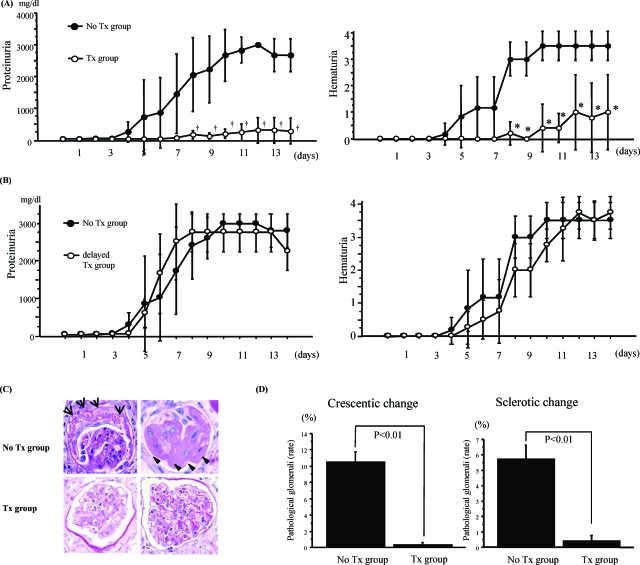Figure 1.
Pretreatment of fasudil prevented renal injury in γ−/− mice with anti-GBM GN. A: Disease course in γ−/− mice with or without fasudil treatment (10 mg/kg i.p. daily) starting from 4 days before NTS injection. Proteinuria increased in the untreated group, but decreased significantly with fasudil treatment (P < 0.01) (left). Hematuria was measured by stick analysis. Fasudil treatment also significantly decreased hematuria (P < 0.01) (right). Data are mean ± SEM values of six mice in each group. †P < 0.01, *P < 0.01. B: Disease course in γ−/− mice with or without fasudil treatment (10 mg/kg i.p. daily) starting from 7 days after NTS injection. Fasudil did not improve proteinuria and hematuria in each group. Data are mean ± SEM value of five mice in each group. C: Fasudil pretreatment attenuated crescent formation and sclerotic change in γ−/− mice with anti-GBM GN. In the untreated group, crescent formation (arrow) and sclerotic change (arrowhead) were seen in many glomeruli (top), but these effects were absent after fasudil treatment (bottom). D: Periodic acid-Schiff staining of at least 200 glomeruli allowed estimation of the number of pathological glomeruli and calculation of the ratio of injured glomeruli. Sclerotic glomeruli were defined by a fibrous change occupying more than half of one glomerulus. Fasudil significantly reduced the sclerotic changes (P < 0.01) (right). Crescent formation analysis was performed in each group. Fasudil markedly reduced crescent formation (P < 0.01) (left). Data are mean ± SEM values of six mice in each group. Original magnifications, ×400.

